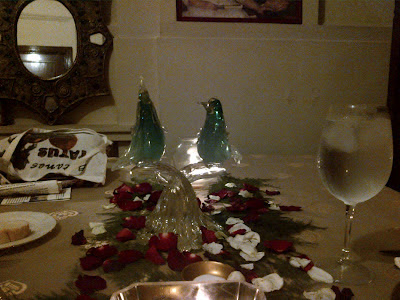La Cocina de Tita Moning: Third time's the charm
After greeting Jose Rizal a happy birthday, Ate Bing, Ate Mary, and I ate dinner at La Cocina de Tita Moning. Yes, I like eating at the restaurant so much that I went there a third time; and each time I go there, I'm with a different set of people. The first time was during my birthday weekend last year and the second was with the family.
As I was driving the car through the restaurant's gate, I noticed that the parking lot outside was busier than usual. The guard, who's checking if people had made reservations before going there, answered my unasked question: there were two big corporate groups that night, eating at the same time slot as we were... and we were in casual attire! Great, we were going to be in the midst of power-dressers and we looked like we were on holiday (which we really were that day).
 |
| By the ancient camera gear collection. |
Despite the fully booked time slot, it didn't feel that there was a crowd at all inside the restaurant. In fact, it felt like I was eating in someone's house rather than in a restaurant. Well, it did help that La Cocina de Tita Moning is actually the Legarda mansion transformed into a restaurant. Smaller groups, like ours, were seated in one of the former sitting rooms while the big group was seated in what used to be the family's main dining room.
 |
| The living room. This is where the Legarda family's art collection and mementos are displayed. |
The table we were assigned to was, as usual, immaculately set. During my first dinner there, I was totally blown away by the intricate designs on the plates and the way the table was prepared, complete with the sarimanok centerpiece. This time around, the table was adorned by two green bird glass sculptures. Sometimes, I wonder, did the family eat in tables set this way every meal time?
 |
| Glass sculpture as a centerpiece. |
In school, I did learn which spoon and which fork is mine in a formal setting through illustrations in books or during lectures; but actually being in front of a real-life set can be a daunting experience. Especially when the waiting staff indicated that the cutlery and the dishware may be as old as my grandmother! But thanks to the sense of formality, I was eating with correct posture and was trying to look as civilized as the next diner. And, no slurping! Maybe I ought to eat more often in these kinds of restaurants to brush up on my table manners.
 |
| Ate Bing and Ate Mary, while we were waiting for our food. |
Now that I've been to La Cocina de Tita Moning three times, I can say that aside from the house and the food, the other thing I like about the restaurant is the service. The waiting staff were very welcoming and very warm; as if we were part of the family. None of that snooty air I see of staff at some upper class restaurants.
Third time's the charm for me indeed. I am definitely bringing my parents there one day.

WOW! ansaya...dami kong extra sa mga entries mo lately =) more more...hehe
ReplyDeletethank you for bringing us there, it's a very superb experience =) fitting for our Syanang Syalen Gala =)
Tama!! Masaya ang kain natin doon :) Hahanap pa ulit tayo ng food-trip-worthy places. Ang plano kong susunod na Manila adventure ay pang August na... o October.
DeleteMay mga susunod pang banggit sa iyo! Di pa tapos ang aking June 19 blog series! Anong petsa na?!?